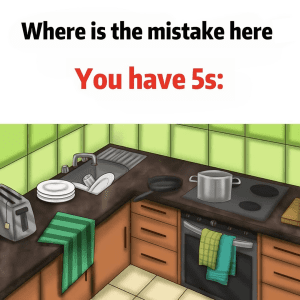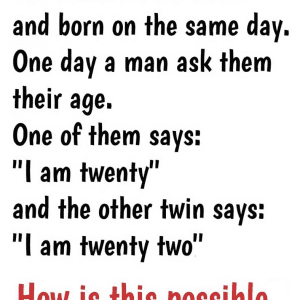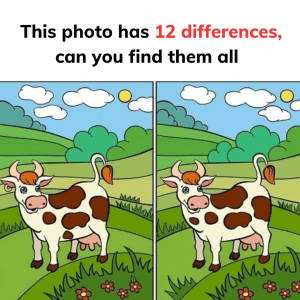Ready to challenge your powers of observation? In this intriguing picture puzzle, your task is to spot the left-handed person among a group of workers. At first glance, it might seem easy, but once you dive in, you’ll realize this puzzle requires keen attention to detail. Think you can figure it out? Let’s break it down and see if you can uncover the left-hander hiding in plain sight!
Why This Puzzle Is Trickier Than It Seems

Spotting a left-handed person isn’t as simple as it sounds. Our brains are trained to make quick assumptions, which can lead us to miss subtle details. For example, we often think if someone is holding an object in their left hand, they must be left-handed. However, this isn’t always true. Sometimes, left-handed people use their right hand for specific tasks, especially in workplaces where tools and equipment are designed for right-handed users.
This puzzle tests not only your ability to observe but also your logical thinking. Let’s explore each character and use practical reasoning to identify the left-hander among them.
Common Mistakes to Avoid When Solving Puzzles Like This
Before jumping into the solution, let’s discuss some common mistakes that puzzle-solvers make:
- Assuming Dominance Based on Position: Just because someone is holding something in one hand doesn’t mean it’s their dominant hand. Many tasks require using both hands interchangeably.
- Relying on Stereotypes: Some people believe left-handed individuals do everything with their left hand, but this isn’t always true. Sometimes left-handed people adapt to using their right hand, especially for tasks where it’s more convenient.
- Ignoring Subtle Cues: Small details, like how an item is held or the angle of the hands, can reveal handedness. Looking for practical indicators rather than making quick assumptions is key.
With these tips in mind, let’s go step-by-step through each character to uncover the left-hander.
Step-by-Step Solution: How to Spot the Left-Handed Person
1. The Chef: A Close Look at the Knife-Handed Cook
The first character on the left is a chef, busy slicing vegetables on a chopping board. Naturally, your first thought might be that the hand holding the knife indicates handedness.
- Observation: The chef holds the knife in his right hand, while his left hand secures the vegetables.
- Conclusion: Chefs, whether left- or right-handed, typically use their dominant hand to control the knife with precision. Here, since he’s using his right hand for cutting, it’s likely he’s right-handed. The chef is probably not our left-handed suspect.
2. The Waitress: Clues in Her Serving Style
Next up is a waitress holding a tray with a cup of coffee. This character’s actions provide the clearest clues for solving the puzzle.
- Observation: The waitress holds the tray with her right hand and uses her left hand to serve. Typically, a right-handed person would do the opposite, holding the tray with their left hand and serving with their right for better balance and ease.
- Conclusion: This unique arrangement suggests she is left-handed, as she uses her dominant left hand for the more active task (serving). The waitress is a strong candidate for being the left-hander.
3. The Photographer: Analyzing Camera Handling
Moving on, we see a photographer crouched down, holding a camera. Cameras are often designed for right-handed use, making it tricky to determine handedness from how someone holds one.
- Observation: The photographer uses both hands to steady the camera, a common practice for any photographer, regardless of handedness.
- Conclusion: Holding a camera this way is typical for both left- and right-handed photographers. Since there are no distinct signs indicating left-handedness, we can likely rule out the photographer.
4. The Office Worker: No Clues in Typing Patterns
The next character is an office worker focused on typing at a desk. Typing is generally an ambidextrous activity, so it doesn’t offer clear signs of handedness.
- Observation: Both hands are on the keyboard, and there’s no specific task revealing a hand preference.
- Conclusion: Typing doesn’t provide any definitive clues about which hand is dominant. This character doesn’t offer enough information to suggest left-handedness, so we’ll move on.
5. The Janitor: Examining the Broom Grip
Finally, we see a janitor holding a broom, with his right hand placed higher on the handle. This position might seem like a clue, but it’s a standard way to hold a broom for balance.
- Observation: The janitor’s right hand is higher on the broom, while his left hand holds the lower part of the handle.
- Conclusion: This hand placement is common for left- and right-handed individuals alike, as it provides stability and leverage. Thus, there’s no clear indication that the janitor is left-handed.
The Verdict: The Waitress Is the Left-Handed Person

After carefully examining each character, the clues point to the waitress as the left-handed person. Her choice to hold the tray with her right hand and serve with her left is a subtle yet clear indicator of left-handedness. This setup allows her to use her dominant hand for the active task of serving, which is more comfortable for a left-handed person.
Why Identifying the Left-Hander Wasn’t as Easy as It Looked
This puzzle was designed to test your observational skills, not just by showing a character using their left hand but by requiring you to think practically about each action. Here’s why this puzzle challenged even the sharpest solvers:
- Intentional Misleading Clues: Characters like the chef and the janitor displayed behaviors that could hint at handedness, but upon closer inspection, these clues didn’t hold up.
- Overlooking Practical Details: Many people miss subtle but significant details, such as the waitress’s choice to serve with her left hand, focusing instead on obvious traits that might not reveal true handedness.
- Encouraging a Practical Perspective: This puzzle reminds us that left-handed individuals don’t just rely on their left hand; they adapt to situations, just as right-handed people do.
Conclusion: Sharpen Your Observation Skills with Fun Puzzles Like This
Did you manage to spot the left-handed person on your first try? Picture puzzles like this offer more than just a fun challenge—they help sharpen your observation skills and encourage a deeper level of analysis. They teach you to look beyond the surface and notice details that are easily overlooked.
So, the next time you encounter a puzzle like this, remember to take your time, think practically, and keep an open mind. If you enjoyed this challenge, try exploring more puzzles to keep your observational skills sharp and your mind engaged. Happy puzzling, and may each new challenge bring out your inner detective!


